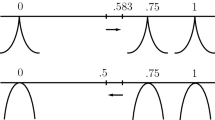Abstract
We investigate policy reform in a modelwith both lobbying, which involves afree-rider problem, and ordinary rentseeking, which does not. These activitiesinvolve similar skills, so a reform whichreduces rents shifts labor into lobbying.Also, because of the free-rider problem,the marginal return to the industry fromlobbying may greatly exceed an individualfirm's return to lobbying. Thus, the shiftinto lobbying caused by rent reduction maylead to large increases in transfers to thelobbying industry. Under somecircumstances, a reform which reducesavailable rents increases total rents plustransfers to the industry.
Similar content being viewed by others
References
Alesina, A. and Drazen, A. (1991). Why are stabilizations delayed? American Economic Review 81: 1170–1188.
Becker, G.S. (1983). A theory of competition among pressure groups for political influence. Quarterly Journal of Economics 98: 371–400.
Bhagwati, J.N. (1978). Foreign trade regimes and economic development: Anatomy and consequences of exchange control regimes. New York: NBER.
Bhagwati, J.N. (1982). Directly-unproductive, profit-seeking (DUP) activities. Journal of Political Economy 90: 988–1002.
Bhagwati, J.N., Brecher, R.A. and Srinivasan, T.N. (1984). DUP activities and economic theory. European Economic Review 24: 291–307.
Bhagwati, J.N. and Srinivasan, T.N. (1980). Revenue seeking: A generalization of the theory of tariffs. Journal of Political Economy 88: 1069–1087.
Conlon, J. and Pecorino, P. (1998). Primary and secondary reform. Economic Inquiry36: 590–602.
Drazen, A. and Grilli, V. (1993). The benefits of crises for economic reforms. American Economic Review 83: 598–607.
Fernandez, R. and Rodrik, D. (1991). Resistance to reform: Status quo bias in the presence of individual-specific uncertainty. American Economic Review 81: 1146–1155.
Findlay, R. and Wellisz, S. (1982). Endogenous tariffs, the political economy of trade restrictions, and welfare. In J.N. Bhagwati (Ed.), Import competition and response, 245–258. Chicago: University of Chicago Press.
Grossman, G. and Helpman, E. (1994). Protection for sale. American Economic Review 84: 833–850.
Hillman, A.L. (1991). Protection, politics, and market structure. In E. Helpman and A. Razin (Eds.), International trade and trade policy. Cambridge, MA: MIT Press.
Katz, E., Nitzan, S. and Rosenberg, J. (1990). Rent-seeking for pure public goods. Public Choice 65: 49–60.
Krueger, A.O. (1974). The political economy of the rent-seeking society. American Economic Review 64: 291–303.
Krueger, A.O. (1978). Foreign trade regimes and economic development: Liberalization attempts and consequences. New York: NBER.
Krueger, A.O. (1990). The political economy of controls: American sugar. In M. Scott and D. Lal (Eds.), Public policy and economic development, 170–216. Oxford: Clarendon Press.
Lohmann, S. (1994). Information aggregation through costly political action. American Economic Review 84: 518–530.
Magee, S.P., Brock, W.A. and Young, L. (1989). Black hole tariffs and endogenous policy theory. Cambridge: Cambridge University Press.
Mayer, W. (1984). Endogenous tariff formation. American Economic Review 74: 970–985.
Nitzan, S. (1991a). Collective rent dissipation. Economic Journal 101: 1522–1534.
Nitzan, S. (1991b). Rent seeking with non-identical sharing rules. Public Choice 71: 43–50.
Nitzan, S. (1994). Modeling rent-seeking contests. European Journal of Political Economy 10: 41–60.
Olson, M. (1965). The logic of collective action. Cambridge, MA: Harvard University Press.
Pecorino, P. (1998). Is there a free-rider problem in lobbying: Endogenous tariffs, trigger strategies, and the number of firms. American Economic Review 88: 652–660.
Rodrik, D. (1986). Tariffs, subsidies, and welfare with endogenous policy. Journal of International Economics 21: 285–299.
Rodrik, D. (1994). The rush to free trade in the developing world: Why so late? Why now? Will it last? In S. Haggard and S.B. Webb (Eds.), Voting for reform: Democracy, political liberalization, and economic adjustment. Oxford: Oxford University Press.
Rosenthal, A. (1993). The third house: Lobbyists and lobbying in the states.Washington, D.C.: Congressional Quarterly Press.
Tullock, G. (1980). Efficient rent seeking. In J.M. Buchanan, R.D. Tollison and G. Tullock (Eds.), Toward a theory of the rent-seeking society.College Station, Texas: Texas A & M University Press.
Wärneryd, K. (1998). Distributional conflict and jurisdictional organization. Journal of Public Economics 69: 435–450.
Author information
Authors and Affiliations
Rights and permissions
About this article
Cite this article
Conlon, J.R., Pecorino, P. Policy Reform and the Free-Rider Problem. Public Choice 120, 123–142 (2004). https://doi.org/10.1023/B:PUCH.0000035858.33925.99
Issue Date:
DOI: https://doi.org/10.1023/B:PUCH.0000035858.33925.99




